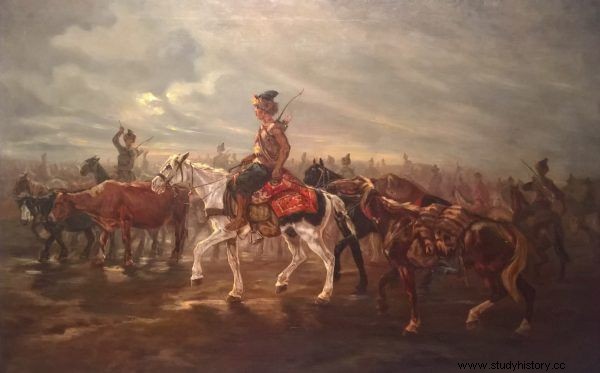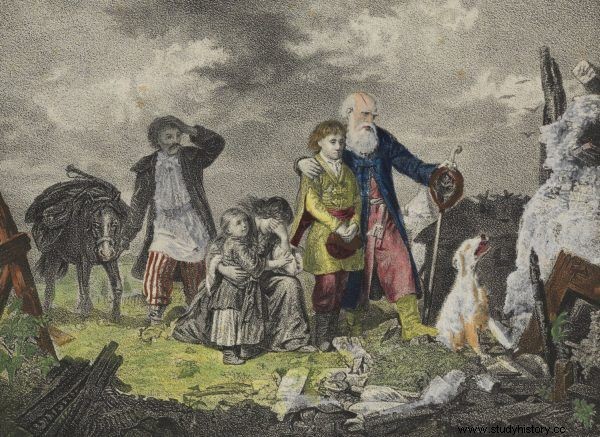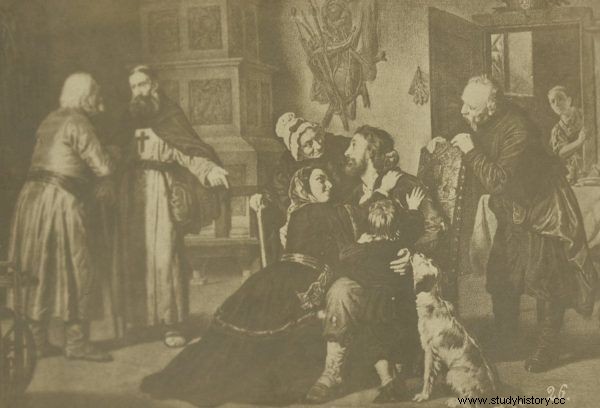They were kidnapped from their hometowns, beaten, raped, driven on foot for hundreds of kilometers and sold like animals at the market. Then they had to work hard for their owners. Hundreds of thousands of inhabitants of the Commonwealth went into Tatar and then Turkish captivity and never returned to their homeland. Hardly anyone remembers their fate today.
From the end of the 15th century, the Commonwealth began to deal with a new scourge - the Tatar invasions. For the Crimean Tatars, robbery expeditions to Polish lands have become a way of life and an important - if not the most important - part of the economy. This people, leading a nomadic way of life, did not cultivate the land and did not produce anything, therefore he made attacks on and looting his neighbors the basis of his existence. Territorially and politically powerful Poland turned out to be a surprisingly defenseless opponent in this respect .
Tatars near Warsaw?
The first major Tatar invasion fell on our country in 1474, followed by others. As historians estimate, by 1586 there were from 150 to even 300 significant expeditions to the Polish-Lithuanian Commonwealth. And we're only talking about the end of the 16th century! The attacks continued in the next century, when they reached their peak. Czambuły reached Lviv, Przemyśl and Rzeszów (!). In 1620, the fear of the Tatars became so great that they began to fortify Warsaw.
Usually, newcomers from Crimea made two raids a year, but there were years when there were even five of them. The smaller ones, called "scolds" (ie five heads), were taken by warriors on their own initiative. During them, from several dozen to about 300 people were kidnapped. The larger ones - "czapuły" (this is where the Polish "czambuł" comes from) - were arranged by local dignitaries, bei and mirzów. They abducted up to three thousand prisoners.

Tatars regularly set out for prisoners of war in the territory of the Polish-Lithuanian Commonwealth.
Finally, there were general expeditions called "sefer". They were organized by the khans - then the entire Tatar power fell on Poland. Several thousand to several tens of thousands of people were taken into jasyr . For example, in the Battle of Łopuszno in 1512, Polish forces recaptured 16,000 people. In turn, according to various reports, during the invasion of 1575, the Tatars seized from 19 to 55 thousand prisoners. The latter estimate gives an idea not only about the scale of the damage, but also about the difficulty of accurately determining the number of losses.
According to the literature, the Commonwealth could lose as much as 300,000 people as a result of the Tatar invasions in the first half of the 17th century. In turn, losses from 1648-1699 could exceed half a million. Some researchers even claim that half a million people went into slavery only during the Khmelnytsky Uprising. The fact is that, as a result of hostile raids, many areas in the South-Eastern Borderlands have become depopulated.
A bag full of children
What was the fate of those who had the misfortune of being captured by the Tatar people? It can be said without exaggeration that hell on earth awaited the victims of the invasions. Fast-moving enemies usually fell on the countryside or town like a bolt from the blue. They killed the elderly and disabled inhabitants right away, took the young ones in jasyr, raped the women, and set the buildings on fire.
The prisoners were put on ropes around their necks and hurried south to avoid being recaptured by possible relief. Tatars circled the column of prisoners, urging them on with hoots. Those who weakened and fell were killed.
Young children were treated equally cruelly. The way of their transport was described in 1689 by Jakub Kazimierz Haur. Well, Tatar took a quilt cover, put a few toddlers inside, made holes for air access, and then hung it over the horse in the shape of a saddlebag and went on the road .
Of course, some of the youngest children did not experience such a journey. Their bodies were simply thrown away. After the invasion of December 1666, the bodies of nearly 500 children who had died from the cold were found on the roads of the Tatar retreat ...
Slavery in Europe
The kidnapped were sold at the Crimean slave markets. People were a sought-after commodity not only in the New World, but also in large areas of Europe. The prisoners of war were divided into groups destined for the Crimea, Constantinople and Anatolia in Asia. Trading took place on certain days of the week.
"As with us for grain, cattle markets or fairs, there is a slave fair there," reported Haur. There were Turkish, Armenian and Jewish merchants who looked for the best captives. The price included young and strong men as well as young, beautiful women. Children and the elderly were paid less. The comparison to the cattle market was absolutely justified. Human commodity was evaluated as it is done with animals. Haur said:
They are poor people, no longer human, but almost bestial then; haggling and buying them, they look everywhere and search them as a rookie [horse trader - ed. PS] what kind of horse abo as an ox butcher, and they see him at once, what can be able to do:if for galleys, if for craftsmanship, or for feeding cattle, or for some domestic service.

Return after the Tatar invasion in a drawing by Leopold Löffler. Maybe the belongings were destroyed, but at least the desperate ones did not find their way to the slave market.
There were Dantesque scenes in the square:“Whoever has not seen this bazaar, has not seen anything in the world. They tear the mother away from her son and daughter, son - from father and brother, and sell them in the midst of lamentation, cry for help, groans and cry ”- wrote Turek Ewlija Czelebi.
Slaves were used extensively in the Ottoman Empire. Usually, men bought from Tatars were sent to the galleys as rowers. It was a hard fate. In the opinion of those times, it was almost a death sentence. This is how Wojciech Miaskowski, a Polish Member of Parliament, described the unfortunate:
When we came to the galley, we saw Christianity several hundred in chains by their feet, with paddles (oars) seated five on either side. So also two executioners alternating with sticks or hangers smeared with tar for walking, and this and the other one on the naked body of the beats.
Miaskowski also learned that "any Pole who does not know what kind of craft in the galleys must die of starvation, because they only give the prisoners a little biscuit and water".
How could the galleys be avoided? It helped to have some practical skill, preferably craftsmanship. Such prisoners were bought willingly and usually they could count on better living conditions. Hussar companion Jan Zygmunt Druszkiewicz, who was captured twice in the Tartars, recalled that a kind Turek bought him the first time . "But he treated me as a son, and I made money:I made heaps of leather straps, bribed (traded) hay, and had money." Others went to work in the land, became servants or simple laborers.
Poles were quite valued in Turkey and had a chance to be treated well. They could also improve their situation by converting to Islam, which many chose to do. It opened the way to a better life and even a career - though not always freedom.
In period documents one can find many descriptions of so-called contractions. These are the Poles who converted to the Prophet's faith and advanced in the Ottoman Empire, becoming officials or even warriors. However, it must be remembered that there was one catch. The change of faith blocked the way to a possible return to the country, as the release of such prisoners was forbidden by the Turkish authorities .
Slave given a facelift
Women bought at the market could end up in the harem and serve as sex slaves, giving birth to more children for you. The older and uglier ones were sent to farm work. Unless you tried to resell them - then a number of tricks were used to improve their appearance (the same was done for men). Ewlija Czelebi described:
A woman who has given birth seven or eight times, with her breasts like sagging bags, leads to the bath, and after bathing, they subject her face, eyes and lower body to these treatments with copervas, dye, quince seeds, alum and razors. In this way, they transform her into an innocent virgin with faces like rubies and breasts like oranges, and put them in tight and colorful dresses, and put her on a bench, where slaves are sold. Then such an old, emaciated woman pretends to be a pretty little girl .
Children kidnapped from Polish, Muscovite or Hungarian lands were circumcised and then "turczono", rearing them as faithful followers of Muhammad. Special military units, called Janissaries, were created from them. Previously, however, they were sexually abused, just like adults. "They deal with innocent children as with calves, not only by applying their faith and rude manners to them, but also by dealing with them in such a way as to write the terror and make changes," wrote Jakub Haur, shocked.
Sometimes captives sold into slavery could be bought back. The family lectured on the richer money. For others, Polish MPs arriving in Istanbul gained freedom, although the latter caused discontent among the Turks - eventually deprived them of the workers they had paid for. Some Armenian merchants and the Trinitarian order also dealt with redemption.
However, it should be remembered that the release of prisoners of war always met with resistance in Turkey. The prices for those bought out were three or four times the cost of an ordinary slave bought at the market . Not all were liberated. Some ended up in remote areas of the empire:Egypt, Tunis, Algiers. There was always a shortage of money for redemption. So it was a norm that Poles spent decades in captivity.

Only a few could count on being redeemed from the Tatar captivity. Above, the drawing "Return from the jasyru" by Leopold Löffler.
When 61 Poles liberated from Turkey were brought to Warsaw in 1727, half of them were old people aged over 60. The oldest of them, Stanisław Komorowski, was 90 years old, and 48 years of imprisonment. Others spent 36, 40 or 44 years in Turkey. Jerzy S. Łątka, an expert in Turkey, reported:
Younger than them, because only Antoni, a 60-year-old liberator, kidnapped as a child, did not know what his name was, noble or non-noble . His 50-year-old companion, also kidnapped as a child, knew his name was Zaleski ….
It can be said without falsehood that most of the hundreds of thousands of Tatar captives abducted on the territory of the Commonwealth remained in captivity forever. They never saw their homeland again.
